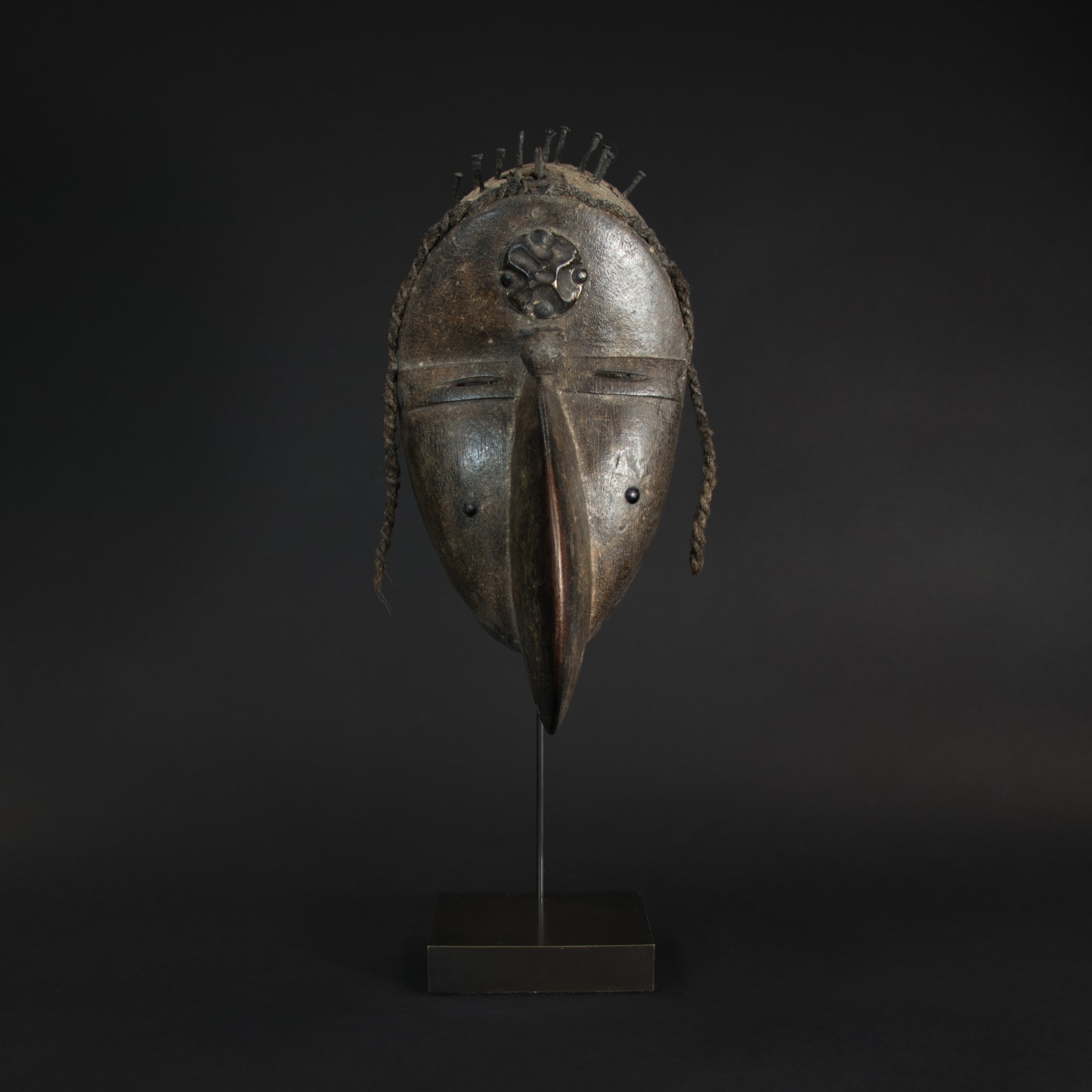Dan Bird Mask (Ge Gon), 19th to 20th century CE
Wood, fibers, and nails
32.5 x 15 cm
12 3/4 x 5 7/8 in
12 3/4 x 5 7/8 in
ES.6350
Further images
This striking mask of a bird’s head was made in Liberia or the Ivory Coast by the Dan tribe, or one of their near relatives. It is distinguished by a...
This striking mask of a bird’s head was made in Liberia or the Ivory Coast by the Dan tribe, or one of their near relatives. It is distinguished by a high forehead, a long, curved beak and arched brows above the eyes. The form of the eyes and the dark patina lend a serene aspect. This mask, with its bird-like beak is known as Ge Gon. Originally educational, historical, and regulartory, it was described as a mask of wisdom. It has progressively become mostly an entertaining mask, that appeals through its bird-like movements in performance.
The Dan are a farming tribe, settled in the semi- wooded areas of Liberia and the ivory Coast. Much of their mythology and social structure is based upon the forest and its fiercer creatures – the Leopard Society is the main organ of social control. For example, initiates spend up to four months alone in the forest before they are permitted to enter maturity. Dan society was originally a string of spatially-proximate but socially distinct communities, and while they are now – technically at least – centralised, their diversity has found expression in the range of masks and other artefacts that they manufacture.
There was scarcely a social function that did not have its own mask prior to the 1960s, from fire-watching (= fire warden), adjudicators, warriors, debt collectors, social delinquents and warriors, and others for enlisting workers to clear paths, to catch runaway wives, to race unmasked athletes (“runner masks”) to snatch feast food to serve to children and even for spying. Small masks – called “passport” masks – were kept as talismans of good luck, to ward off illness or the evil eye, and to serve as markers of authority and ambassadorial functions. Masks were inherited through lineages, kept on altars and endowed with libations. Some retain black pitch-like substances which are presumed to be the remains of magical materials.
Function is not always easy to ascertain, paradoxically, as the masks were usually associated with costumes that have not survived, and of course with particular occasions, dances or people. In lacking these, we have only stylistic tendencies to go on. This is a highly distinctive variant of the Gagon mask, a northern Dan form, which is usually worn for entertainment as much as ritual purposes.
This is a powerful piece of African art.
The Dan are a farming tribe, settled in the semi- wooded areas of Liberia and the ivory Coast. Much of their mythology and social structure is based upon the forest and its fiercer creatures – the Leopard Society is the main organ of social control. For example, initiates spend up to four months alone in the forest before they are permitted to enter maturity. Dan society was originally a string of spatially-proximate but socially distinct communities, and while they are now – technically at least – centralised, their diversity has found expression in the range of masks and other artefacts that they manufacture.
There was scarcely a social function that did not have its own mask prior to the 1960s, from fire-watching (= fire warden), adjudicators, warriors, debt collectors, social delinquents and warriors, and others for enlisting workers to clear paths, to catch runaway wives, to race unmasked athletes (“runner masks”) to snatch feast food to serve to children and even for spying. Small masks – called “passport” masks – were kept as talismans of good luck, to ward off illness or the evil eye, and to serve as markers of authority and ambassadorial functions. Masks were inherited through lineages, kept on altars and endowed with libations. Some retain black pitch-like substances which are presumed to be the remains of magical materials.
Function is not always easy to ascertain, paradoxically, as the masks were usually associated with costumes that have not survived, and of course with particular occasions, dances or people. In lacking these, we have only stylistic tendencies to go on. This is a highly distinctive variant of the Gagon mask, a northern Dan form, which is usually worn for entertainment as much as ritual purposes.
This is a powerful piece of African art.







